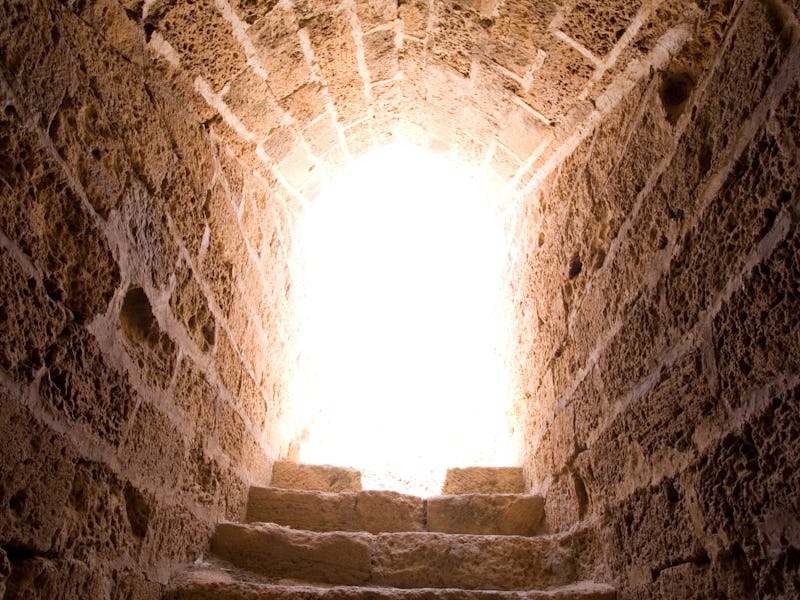Ancient shrine reveals how marijuana was used to evoke "religious ecstasy"
"It was forgotten for 50 years."

Scientists in Israel believe they’ve found evidence of some of the oldest, and holiest, rollers in biblical history. Deep in the inner sanctum of an 8th century BCE shrine, worshippers weren’t just burning frankincense. They were also burning marijuana.
The Tel Arad fortress is believed to be the southernmost stronghold for the Kingdom of Judah, which was formed after the death of King Solomon. When that fortress was excavated in the 1960s, scientists found evidence of a religious shrine on the northwestern edge of the site. Within that shrine, scientists found a room containing cult objects and two stone altars with a black clump of organic material carefully placed on top of each one.
Decades later, a new chemical analysis of that plant material revealed that one altar (the larger one) like contained frankincense.
Meanwhile, the smaller altar bore no evidence of myrrh nor gold. Instead, scientists found trace evidence of Δ9-teterahydrocannabinol (THC), cannabidiol (CBD), and cannabinol (CBN) — all chemicals that are present in marijuana.
These findings were published Wednesday in the journal Tel Aviv.
Eran Arie is the curator of Iron Age and Persian Period Archaeology at the Israel Museum in Jerusalem and the study's lead author. He tells Inverse this discovery was “the most amazing surprise.” It suggests that cannabis was probably involved in cult rituals in biblical Judah. Most likely, he says, to evoke a type of “religious ecstasy.”
“The fact that they were probably bringing cannabis from afar, bringing it into the temple and putting it onto a different altar, is why we assume that it was for the purposes of this ecstasy and not anything else.”
The two altars. The larger altar contained frankincense. The smaller one had traces of marijuana.
Neglected and forgotten – As Arie explains, we’ve known that there was unidentified plant matter on altars in the Arad shrine since it was first excavated. But in the 1960s, scientists struggled to identify it. In the intervening decades, the shrine remained on display at the Israel Museum. But the plant matter was forgotten.
"It was neglected for nearly 50 years," he says.
One of the things that excites Arie most about this work is that it shows how far the field of archaeology has come. These unidentified plant samples gave archaeologists the opportunity to use new types of scientific analysis, specifically gas chromatography and mass spectrometry, which allows scientists to separate and analyze compounds to determine what they are.
“In the last ten years, near eastern archaeology became much more scientific than in the past,” he says.
The time had finally arrived to figure out what these ancient Judahites were burning in their temple.
The Tel Arad fortress, where the shrine was unearthed in the 1960s.
The larger altar contained frankincense mixed with animal fat, to encourage evaporation. On the cannabis altar, the team found evidence of terpenes, the chemicals that give cannabis its fragrance, which suggests that cannabis flowers had been burned. But they also found evidence of animal dung, suggesting that cannabis resin was mixed with feces to promote burning.
Arie says finding frankincense is about par for the course for that time period – it's consistently mentioned in Assyrian texts and the Bible. But the cannabis provided a surprising window into another level of religious life in the ancient world.
The first evidence of the use of cannabis as a psychoactive goes back far further than the 8th century BCE. In 2019, scientists found evidence of THC in funerary incense burners found in central Asia.
The authors of that study suggested that these finds were evidence that people were using marijuana in a religious context. Those people were likely the Scythians, nomadic warriors who lived roughly 2,500 years ago.
Marijuana's religious context at the Arad shrine, says Arie, is extremely clear: The two altars were found on a staircase that leads to the innermost sanctum of the shrine, which is referred to as the holy of holies. (That term is in reference to a similar area found within the ancient Temple of Jerusalem. The holy of holies was a most sacred space, and can only be entered by the Israelite high priest.)
The fact that the cannabis was found on an altar in the Arad shrine's holy of holies helps confirm its religious nature, says Arie.
“I don’t think there is any doubt about the cultic context of the find,” says Arie. “Ecstasy or a religious state of consciousness was part of the cult of Judah,” he says.
Nowadays, scientists are finding new uses for marijuana and all its chemical compounds. But these finds at Arad demonstrate that humans have been getting creative with weed for centuries. Even in biblical times, getting high perhaps made us feel a little closer to God.
Abstract: Two limestone monoliths, interpreted as altars, were found in the Judahite shrine at Tel Arad. Unidentified dark material preserved on their upper surfaces was submitted for organic residue analysis at two unrelated laboratories that used similar established extraction methods. On the smaller altar, residues of cannabinoids such as Δ9-teterahydrocannabinol (THC), cannabidiol (CBD) and cannabinol (CBN) were detected, along with an assortment of terpenes and terpenoids, suggesting that cannabis inflorescences had been burnt on it. Organic residues attributed to animal dung were also found, suggesting that the cannabis resin had been mixed with dung to enable mild heating. The larger altar contained an assemblage of indicative triterpenes such as boswellic acid and norursatriene, which derives from frankincense. The additional presence of animal fat―in related compounds such as testosterone, androstene and cholesterol―suggests that resin was mixed with it to facilitate evaporation. These well-preserved residues shed new light on the use of 8th century Arad altars and on incense offerings in Judah during the Iron Age.